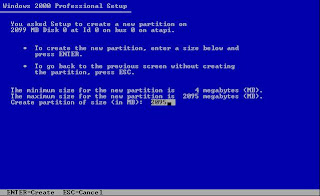Windows 2000 Professional step by step installation process
The Windows 2000 Professional installation step-by-step procedure with screenshots.
A. Set your computer to boot from the CD-ROM drive by changing computer BIOS Boot Sequence setting.
B. Insert Windows 2000 Professional installation CD into the CD-ROM drive and reboot the computer so that the computer will boot from Windows 2000 Professional installation CD-ROM that already on the CD-ROM drive.
C. After your computer boot the Windows 2000 Professional installation CD-ROM, the Windows 2000 Setup then start checking the system configuration and loading files driver.
1) Windows Setup Screen:
Shall we begin?
After configuring the system for booting from a CD, the Windows Setup screen appears.
At this point, Setup is loading the driver files it needs to continue with installation.
2) Welcome to Setup:
The Welcome to Setup screen appears with the option of Continuing Setup, Repair a previous installation, or Quitting.
Press ENTER to Continue Setup, R to Repair, or F3 to Quit and reboot the system.
3) Windows 2000 Licensing Agreement:
The Windows 2000 Licensing Agreement screen, otherwise known as EULA, displays the legal in's and out's of this particular software package.
You may press F8 to signify that you agree with the terms, hit ESC if you do not agree and PAGE UP or PAGE DOWN to scroll through each screen. Note: If you do not agree to the terms, setup will quit and reboot the system.
4) Hard drive partition information:
Hard drive partition information is now displayed. This varies with each systems hardware configuration.
This example already has a partition defined. I will choose not to use this and create a new one by pressing D. You may skip this and the next few steps if you do not have any partitions defined.
At this point, the options include pressing ENTER to Install on the selected partition, D to Delete the selected partition, or F3 to Quit and reboot the system.
5) Warning screen:
After pressing D to delete the selected partition, a warning screen appears explaining the pitfalls of deleting it. This particular screen only appears when the partition selected to be deleted is formatted as a bootable system partition. Other partitions will display the next screen.
I want this to happen, so I press ENTER to continue.
The options include pressing ENTER to continue, or ESC to Cancel.
6) Confirmation screen:
A confirmation screen that displays the logical drive, what file system the partition is currently using, the size in MB and controller information.
Options include L to Delete the partition and ESC to Cancel the action.
7) No partitions have been previously defined:
If no partitions have been previously defined, this screen will be displayed. You may section your hard drive in as many partitions as you wish by selecting C to Create a Partition and then entering in a value less then the total available. Here, I will Create a Partition in the highlighted, unused portion.
Select the partition you wish to install to using the UP ARROW and DOWN ARROW keys.
Press ENTER to use the highlighted partition and Install, C to Create a Partition, or F3 to Quit and reboot the system.
8) Enter in the partition size:
Enter in the partition size in MB within the displayed minimum and maximum. I chose the default or maximum available here.
You may choose ENTER to Create the new partition or ESC to Cancel the action.
9) Continue to create partitions:
Continue to create partitions until all space is used or the configuration meets your requirements. Note: a small portion will be unavailable to partition. This is normal. In this example, it is 4 MB.
I chose drive C: to install the Operating system.
You may choose ENTER to Install to the selected partition, D to Delete the highlighted Partition, or F3 to Quit and reboot the system.
10) Format the partition:
Since this OS supports NTFS, format the partition with it. If you do not, many folder and file security features will be unavailable. Note: If you are dual booting your system, a previous OS will not be able to read the local information. This is a fact with Windows 9x and Me. If you have a requirement to view this partition from another OS installed on the system, do not format it as NTFS. Also, the boot partition must be formatted with FAT32 if you wish to dual boot. I have found no problems accessing a NTFS partition mapped as a network drive from an older OS.
Select what format you wish to use by pressing the UP ARROW and DOWN ARROW keys.
Press ENTER to confirm your selection and Continue or ESC to Cancel.
11) Setup formats the partition:
Watch the progress bar as Setup formats the partition, or get up and get a soda. It may take awhile.
12) Creating File List:
Setup is now figuring out what files to copy over to the hard drive.
13) Setup copies various files:
After the partition is finished formatting, Setup copies various files to support booting from the hard drive and continue on.
14) Creating various information files:
Setup then creates various information files required to continue on with setup
15) Press ENTER to Restart
The first reboot and the end of the blue background has arrived. If you are impatient, press ENTER to Restart before the 15 seconds expire.
ENTER to Restart the Computer is the only option available
























0 comments:
Post a Comment